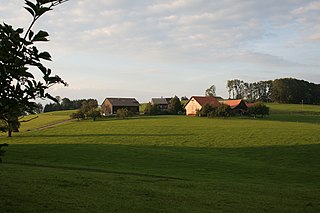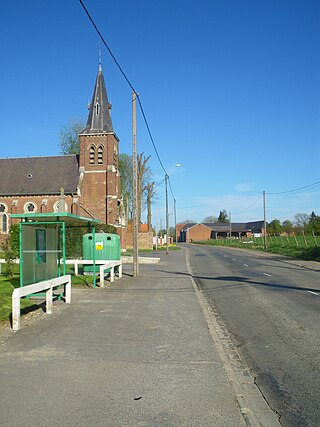
Bavaria, officially the Free State of Bavaria, is a state in the southeast of Germany. With an area of 70,550.19 km2 (27,239.58 sq mi), it is the largest German state by land area, comprising roughly a fifth of the total land area of Germany, and with over 13.08 million inhabitants, it is the second most populous German state, behind only North Rhine-Westphalia; however, due to its large land area, its population density is below the German average. Major cities include Munich, Nuremberg, and Augsburg.

A municipality is usually a single administrative division having corporate status and powers of self-government or jurisdiction as granted by national and regional laws to which it is subordinate.

The Munich massacre was a terrorist attack during the 1972 Summer Olympics in Munich, West Germany, carried out by eight members of the Palestinian militant organization Black September. The militants infiltrated the Olympic Village, killed two members of the Israeli Olympic team, and took nine others hostage, who were later killed in a failed rescue attempt.

The 1936 Summer Olympics, officially the Games of the XI Olympiad and officially branded as Berlin 1936, was an international multi-sport event held from 1 to 16 August 1936 in Berlin, Germany. Berlin won the bid to host the Games over Barcelona at the 29th IOC Session on 26 April 1931. The 1936 Games marked the second and most recent time the International Olympic Committee gathered to vote in a city that was bidding to host those Games. Later rule modifications forbade cities hosting the bid vote from being awarded the games.

Schaumburg is a village located mostly in Cook County and partly in DuPage County in northeastern Illinois, United States. Per the 2020 Census, the population was 78,723, making Schaumburg the most populous incorporated village in the United States. Schaumburg is around 28 miles (45 km) northwest of the Chicago Loop and 10 miles (16 km) northwest of O'Hare International Airport. It is part of the Golden Corridor.

The Battle of Leipzig, also known as the Battle of the Nations, was fought from 16 to 19 October 1813 at Leipzig, Saxony. The Coalition armies of Austria, Prussia, Sweden, and Russia, led by Tsar Alexander I and Karl von Schwarzenberg, decisively defeated the Grande Armée of French Emperor Napoleon Bonaparte. Napoleon's army also contained Polish and Italian troops, as well as Germans from the Confederation of the Rhine. The battle was the culmination of the German Campaign of 1813 and involved 560,000 soldiers, 2,200 artillery pieces, the expenditure of 400,000 rounds of artillery ammunition, and 133,000 casualties, making it the largest battle of the Napoleonic Wars, and the largest battle in Europe prior to World War I.

Sopot is a seaside resort city in Pomerelia on the southern coast of the Baltic Sea in northern Poland, with a population of approximately 40,000. It is located in Pomerania Province and has the status of county – the smallest city in Poland to have that status. Sopot lies between the larger cities of Gdańsk to the southeast and Gdynia to the northwest. The three cities together form the Tricity metropolitan area.

A hamlet is a human settlement that is smaller than a town or village. This is often simply an informal description of a smaller settlement or possibly a subdivision or satellite entity to a larger settlement. Sometimes a hamlet is defined for official or administrative purposes.

The massacres of Poles in Volhynia and Eastern Galicia were carried out in German-occupied Poland by the Ukrainian Insurgent Army (UPA) with the support of parts of the local Ukrainian population against the Polish minority in Volhynia, Eastern Galicia, parts of Polesia and the Lublin region from 1943 to 1945. The ruling Germans also actively encouraged both Ukrainians and Poles to kill each other.

The Battle of Pozières took place in northern France around the village of Pozières, during the Battle of the Somme. The costly fighting ended with the British in possession of the plateau north and east of the village, in a position to menace the German bastion of Thiepval from the rear. The Australian official historian Charles Bean wrote that Pozières ridge "is more densely sown with Australian sacrifice than any other place on earth".

Oberstdorf is a municipality and skiing and hiking town in Germany, located in the Allgäu region of the Bavarian Alps. It is the southernmost settlement in Germany and one of its highest towns.

Hagermarsch is a village and municipality in the district of Aurich, in Lower Saxony, Germany. It is located northeast of the city of Norden. Together with four other municipalities in the region, it is part of the municipal association (Samtgemeinde) of Hage, of which Hagermarsch is the smallest population-wise.

Gommecourt is a commune in the Pas-de-Calais department in the Hauts-de-France region of France.

Launstroff is a commune in the Moselle department in Grand Est in north-eastern France.

Haspelschiedt is a commune in the Moselle department of the Grand Est administrative region in north-eastern France. The population in 2018 was 301 inhabitants.

The River Tiddy is a small river in south-east Cornwall, England, United Kingdom. It is the main tributary of the River Lynher. The Tiddy rises near Pensilva and flows south east past the village of Tideford until it joins the Lynher just after passing St Germans. The name of Tideford derives from its location on the river, literally meaning "Ford on the River Tiddy".
The Federal Inventory of Heritage Sites (ISOS) is part of a 1981 Ordinance of the Swiss Federal Council implementing the Federal Law on the Protection of Nature and Cultural Heritage.

Hilgenried Bay is a bay on the German North Sea coast near Hilgenriedersiel, a village in the municipality of Hagermarsch in the Lower Saxon county of Aurich. It was probably formed during the Dunkirk transgression as a result of the washing out of the mouth of one or more small streams, but has now largely silted up.

The Battle of Norditi, Battle of Nordendi or Battle of Hilgenried Bay was a battle between a Frisian army under Archbishop Rimbert of Bremen-Hamburg and an army of Danish Vikings in 884, which resulted in the complete withdrawal of the Vikings from East Frisia.

Hilgenriedersiel is a village in the region of East Frisia, Lower Saxony, Germany. It is an Ortsteil of the municipality of Hagermarsch, part of the municipal association (Samtgemeinde) of Hage. The village borders the Wadden Sea to the north, looks out on the island of Norderney, and has the only natural bathing area on the East Frisian North Sea coast. Near Hilgenriedersiel is the Hilgenried Bay.






















